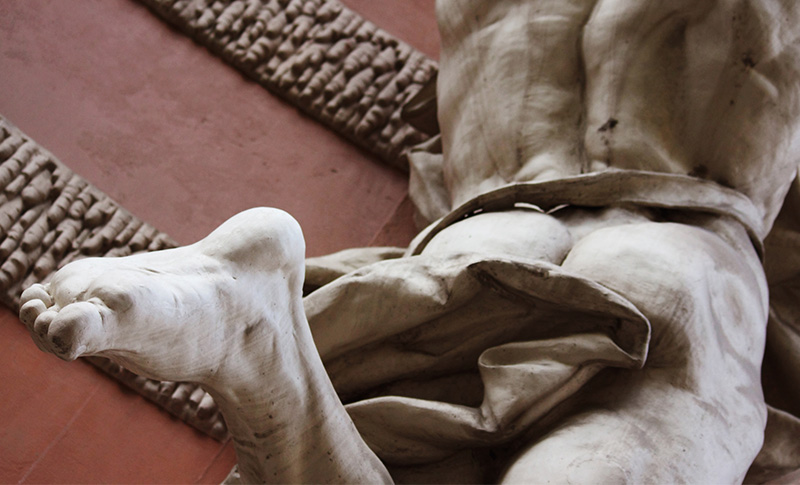In Greek mythology, Achilles was the son of King Peleus, a mortal, and a sea nymph, Thetis, and the greatest warrior of the Trojan War. His mother attempted to render him invulnerable by dipping him in the River Styx, protecting his body except for the heel by which she held him for the dipping: his Achilles heel.
Our own Achilles tendons are the strong bands of fibres that connect our calf muscles to the heel. As legend implies, they are, indeed, vulnerable to injury. These injuries generally happen when you begin moving suddenly, pushing off with your foot. Achilles tendinitis (or tendonitis) and a ruptured Achilles tendon are the most common injuries to this tendon.
What is Achilles Tendinitis?
Achilles Tendinitis is an overuse injury due to repetitive motion that can cause pain, inflammation or degeneration of the tendon. It is common among runners and jumpers.
Achilles tendinitis can result from:
- Increasing the duration or intensity of your runs.
- Playing sports only on the weekends in middle age.
- Sudden change in your training surface (e.g., asphalt to grass).
- Flat feet that over-pronate.
- Feet with high arches and tight Achilles tendons.
- Tight hamstrings and calf muscles.
- Shoes without enough support.
Signs and symptoms
- Achilles tendinitis usually starts with mild pain after exercise that requires repetitive motion. You’ll generally feel a mild ache in the back of the leg or heel afterward.
- During the night or when you awaken in the morning, you may feel more pain and stiffness.
- If inflammation is involved, the area may be red, swollen, tender or warm.
- Use of the tendon may result in a crunchy feeling.
Diagnosis: Your physician will examine your ankle and your foot and assess the range of motion and the condition of the tendon. X-rays or other types of imaging may be used.
Achilles Tendinitis Treatment
Once your achilles tendinitis is diagnosed by a doctor, a visit to the physiotherapist is generally in order. Here’s what to expect for your Achilles tendinitis treatment:
- Your pain threshold will be assessed and any movements that cause increase pain identified.
- If there is inflammation involved, your physiotherapist may use ultrasound to reduce it and stimulate blood flow, which promotes healing.
- Deep massage to improve flexibility and further increase blood flow.
- Stretching and flexibility exercises that can assist in healing without shortening the tendon.
- Strengthening exercises to protect against further injury while helping your regain any strength that has been lost.
- Additional support: Your physician may suggest orthotics to elevate your heel, relieve strain on the tendon and lessen the amount of force it absorbs during exercise.

Recognizing an Achilles Tendon Rupture
What is an Achilles tendon rupture? A rupture is a tear in the Achilles tendon when an abrupt movement is too much for the tendon to handle. It can occur spontaneously, without warning, or you may have experienced tendinitis previously.
Achilles Tendon Rupture Symptoms
- You may feel a sudden, sharp pain above your heel as the tendon releases the calf muscle.
- There may be a popping or snapping sensation.
- The back of the leg between heel and calf may swell.
- You’ll have difficulty walking, especially up stairs or uphill.
Diagnosis: A physician or surgeon will ask about your history and the circumstances surrounding the injury. A physical exam will include an evaluation of range of motion and muscle strength, comparing it to the uninjured foot. The diagnosis is usually straightforward, but imaging tests may be required.
Treatment
Immediately after the injury, use the RICE method of treating your achilles: rest, ice, compression and elevation.
Non-surgical option for a ruptured achilles tendon:
- Minor or partial ruptures.
- Less active patients.
- Patients with medical conditions that prevent surgery.
- Employs a cast, walking boot or brace with a heal lift to support the tendon and allow it to heal.
Archilles rupture surgery:
- Decreases likelihood of another rupture.
- May improve push-off strength.
- Generally improves muscle function and ankle movement.
- Requires an incision and stitching the tendon back together.
Achilles Rupture Recovery
Healing from surgery usually takes four to six months. Effort is required to restore your heel to health. Your physician will generally recommend physiotherapy to:
- Strengthen the tendon.
- Regain flexibility.
- Improve agility.
Post-Recovery
Take things slowly. Don’t return to your previous level of physical activity until:
- Your healed leg feels as strong as your other leg.
- You can move your healed leg as freely and easily as your other leg.
- You feel no leg pain when you walk, run and sprint.
An Achilles tendon injury is treatable, so don’t despair.
